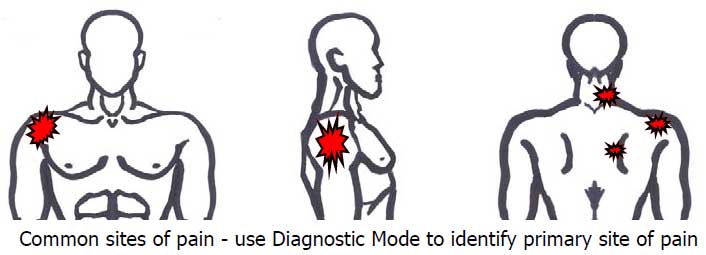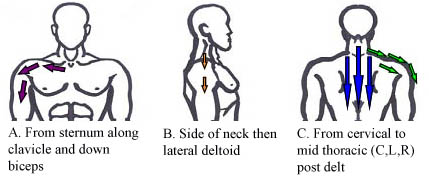|
ENART and SCENAR treatment of SHOULDER PAIN
 Frozen shoulder or 'Adhesive Capsulitis' is a common Frozen shoulder or 'Adhesive Capsulitis' is a common
cause of shoulder pain in people aged between 40 and 60,
with women affected more than men.
Rotator Cuff injury is a common cause of shoulder pain.
Injury to the Rotator Cuff will usually begin as inflammation,
commonly called Rotator Cuff tendonitis.
Shoulder bursitis is a common cause of shoulder pain that is
often related to rotator cuff injury and tendonitis.
Acromioclavicular joint sprain or 'shoulder separation' is a
common cause of shoulder pain. A shoulder separation usually
occurs when there is either a fall onto an out stretched hand or
direct contact to the tip of the shoulder.
A dislocated shoulder is a common shoulder injury in contact
sports such as rugby and martial arts. A dislocated shoulder is
characterised by severe shoulder pain and hospital treatment is
required to restore normal shoulder anatomy.
Rotator Cuff Calcific Tendonitis is characterised by calcium 
deposits in the tendons of the rotator cuff muscles of the
shoulder.
BEFORE TREATMENT:
What is the history of the presenting problem?
Assess pain score (0-10) and record result.
Assess ROM in all directions and record results.
Is pain worse on movement or at rest?
Palpate for inflammation in soft tissue and bones.
Is there loss of sensation, hypersensitivity or
radiating pain into the arm or hand?
Is pain made worse with neck movement?
PROTOCOL
1. With the client seated: 
2. Identify primary site of pain
using diagnostic mode/s
3. Use mid to high power setting
4. Treat primary site using
Constant mode
5. Use FM and follow steps
A, B & C
6. Assess shoulder ROM and
pain score
7. Treat any additional areas of
pain with FM - repeat step 6
8. Stop treatment when 
symptoms subside
SPECIAL NOTES:
ENART can be safely applied over
the spine and/or metal implants and
artificial joints. If blood pressure is
low reverse direction of A, B & C.
Do not use when pacemaker is fitted
Re-treatment - Acute - 2-5 days;
Chronic - 5-10 day.
Caution: Seek medical advice if necessary.
If pain has been caused through trauma advise client that x-ray examination may be required.
If no response to treatment, refer client to their doctor for further diagnosis.
Author
Alastair McLoughlin BTAA, LCSP (Hon.),
United Kingdom
|